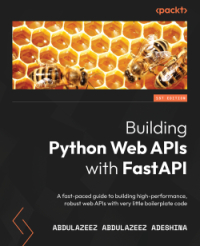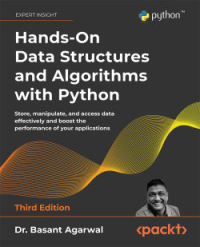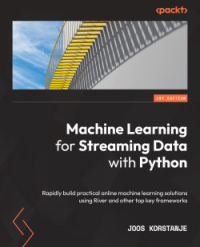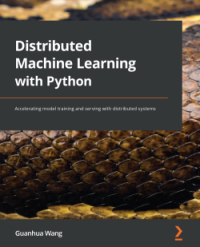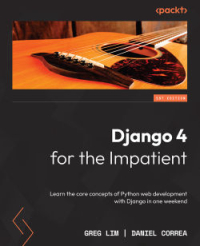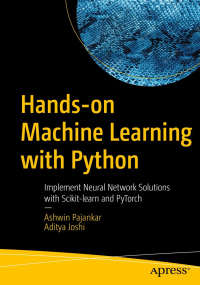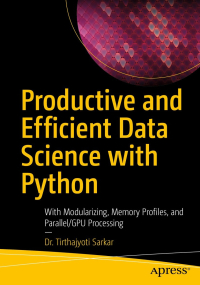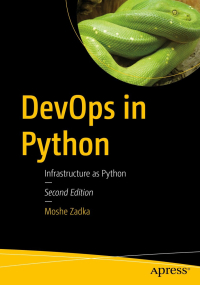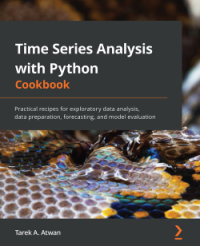Python eBooks
Building Python Web APIs with FastAPI
RESTful web services are commonly used to create APIs for web-based applications owing to their light weight and high scalability. This book will show you how FastAPI, a high-performance web framework for building RESTful APIs in Python allows you to build robust web APIs that are simple and intuitive and makes it easy to build quickly with very little boilerplate code. This book will help you set up a FastAPI application in no time and show you how to use FastAPI to build a REST API that receives and responds to user requests. You'll go on to learn how to handle routing and authentication while working with databases in a FastAPI application. The book walks you through the four key areas: building and using routes for create, read, update, and delete (CRUD) operations; connecting the application to SQL and NoSQL databases; securing the application built; and deploying your application locally or to a cloud environment. By the end of this book, you'll have developed a soli ...
RESTful web services are commonly used to create APIs for web-based applications owing to their light weight and high scalability. This book will show you how FastAPI, a high-performance web framework for building RESTful APIs in Python allows you to build robust web APIs that are simple and intuitive and makes it easy to build quickly with very little boilerplate code. This book will help you set up a FastAPI application in no time and show you how to use FastAPI to build a REST API that receives and responds to user requests. You'll go on to learn how to handle routing and authentication while working with databases in a FastAPI application. The book walks you through the four key areas: building and using routes for create, read, update, and delete (CRUD) operations; connecting the application to SQL and NoSQL databases; securing the application built; and deploying your application locally or to a cloud environment. By the end of this book, you'll have developed a soli ...
Hands-On Data Structures and Algorithms with Python, 3rd Edition
Choosing the right data structure is pivotal to optimizing the performance and scalability of applications. This new edition of Hands-On Data Structures and Algorithms with Python will expand your understanding of key structures, including stacks, queues, and lists, and also show you how to apply priority queues and heaps in applications. You'll learn how to analyze and compare Python algorithms, and understand which algorithms should be used for a problem based on running time and computational complexity. You will also become confident organizing your code in a manageable, consistent, and scalable way, which will boost your productivity as a Python developer. By the end of this Python book, you'll be able to manipulate the most important data structures and algorithms to more efficiently store, organize, and access data in your applications. ...
Choosing the right data structure is pivotal to optimizing the performance and scalability of applications. This new edition of Hands-On Data Structures and Algorithms with Python will expand your understanding of key structures, including stacks, queues, and lists, and also show you how to apply priority queues and heaps in applications. You'll learn how to analyze and compare Python algorithms, and understand which algorithms should be used for a problem based on running time and computational complexity. You will also become confident organizing your code in a manageable, consistent, and scalable way, which will boost your productivity as a Python developer. By the end of this Python book, you'll be able to manipulate the most important data structures and algorithms to more efficiently store, organize, and access data in your applications. ...
Beginning MicroPython with the Raspberry Pi Pico
Program the Raspberry Pi Pico, the latest microcontroller board from raspberrypi.org, with MicroPython. This book will take you on a tour of the Raspberry Pi Pico, including how to get started using the microcontroller, seeing which alternative microcontrollers are available, and how to connect and run simple code examples. You'll program example projects in MicroPython using Python on your PC as a learning platform. Then build your hardware skillset working with electronics and breadboard circuits. You'll implement example projects with all steps explained, including hardware connections and executing the project. Then apply them to real-world, approachable projects using the accessible Raspberry Pi Pico! The book shows how the cloud is used for IoT data and find out what popular cloud systems currently exist for IoT. Finally, you'll use ThingSpeak for hosting IoT data including connecting your Pico to the Internet. Beginning MicroPython with the Raspb ...
Program the Raspberry Pi Pico, the latest microcontroller board from raspberrypi.org, with MicroPython. This book will take you on a tour of the Raspberry Pi Pico, including how to get started using the microcontroller, seeing which alternative microcontrollers are available, and how to connect and run simple code examples. You'll program example projects in MicroPython using Python on your PC as a learning platform. Then build your hardware skillset working with electronics and breadboard circuits. You'll implement example projects with all steps explained, including hardware connections and executing the project. Then apply them to real-world, approachable projects using the accessible Raspberry Pi Pico! The book shows how the cloud is used for IoT data and find out what popular cloud systems currently exist for IoT. Finally, you'll use ThingSpeak for hosting IoT data including connecting your Pico to the Internet. Beginning MicroPython with the Raspb ...
Python for ArcGIS Pro
Integrating Python into your day-to-day ArcGIS work is highly recommended when dealing with large amounts of geospatial data. Python for ArcGIS Pro aims to help you get your work done faster, with greater repeatability and higher confidence in your results. Starting from programming basics and building in complexity, two experienced ArcGIS professionals-turned-Python programmers teach you how to incorporate scripting at each step: automating the production of maps for print, managing data between ArcGIS Pro and ArcGIS Online, creating custom script tools for sharing, and then running data analysis and visualization on top of the ArcGIS geospatial library, all using Python. You'll use ArcGIS Pro Notebooks to explore and analyze geospatial data, and write data engineering scripts to manage ongoing data processing and data transfers. This exercise-based book also includes three rich real-world case studies, giving you an opportunity to apply and extend the conce ...
Integrating Python into your day-to-day ArcGIS work is highly recommended when dealing with large amounts of geospatial data. Python for ArcGIS Pro aims to help you get your work done faster, with greater repeatability and higher confidence in your results. Starting from programming basics and building in complexity, two experienced ArcGIS professionals-turned-Python programmers teach you how to incorporate scripting at each step: automating the production of maps for print, managing data between ArcGIS Pro and ArcGIS Online, creating custom script tools for sharing, and then running data analysis and visualization on top of the ArcGIS geospatial library, all using Python. You'll use ArcGIS Pro Notebooks to explore and analyze geospatial data, and write data engineering scripts to manage ongoing data processing and data transfers. This exercise-based book also includes three rich real-world case studies, giving you an opportunity to apply and extend the conce ...
Machine Learning for Streaming Data with Python
Streaming data is the new top technology to watch out for in the field of data science and machine learning. As business needs become more demanding, many use cases require real-time analysis as well as real-time machine learning. This book will help you to get up to speed with data analytics for streaming data and focus strongly on adapting machine learning and other analytics to the case of streaming data. You will first learn about the architecture for streaming and real-time machine learning. Next, you will look at the state-of-the-art frameworks for streaming data like River. Later chapters will focus on various industrial use cases for streaming data like Online Anomaly Detection and others. As you progress, you will discover various challenges and learn how to mitigate them. In addition to this, you will learn best practices that will help you use streaming data to generate real-time insights. By the end of this book, you will have gained the confidence you need to stream ...
Streaming data is the new top technology to watch out for in the field of data science and machine learning. As business needs become more demanding, many use cases require real-time analysis as well as real-time machine learning. This book will help you to get up to speed with data analytics for streaming data and focus strongly on adapting machine learning and other analytics to the case of streaming data. You will first learn about the architecture for streaming and real-time machine learning. Next, you will look at the state-of-the-art frameworks for streaming data like River. Later chapters will focus on various industrial use cases for streaming data like Online Anomaly Detection and others. As you progress, you will discover various challenges and learn how to mitigate them. In addition to this, you will learn best practices that will help you use streaming data to generate real-time insights. By the end of this book, you will have gained the confidence you need to stream ...
Distributed Machine Learning with Python
Reducing time cost in machine learning leads to a shorter waiting time for model training and a faster model updating cycle. Distributed machine learning enables machine learning practitioners to shorten model training and inference time by orders of magnitude. With the help of this practical guide, you'll be able to put your Python development knowledge to work to get up and running with the implementation of distributed machine learning, including multi-node machine learning systems, in no time. You'll begin by exploring how distributed systems work in the machine learning area and how distributed machine learning is applied to state-of-the-art deep learning models. As you advance, you'll see how to use distributed systems to enhance machine learning model training and serving speed. You'll also get to grips with applying data parallel and model parallel approaches before optimizing the in-parallel model training and serving pipeline in local clusters or cloud environments. By ...
Reducing time cost in machine learning leads to a shorter waiting time for model training and a faster model updating cycle. Distributed machine learning enables machine learning practitioners to shorten model training and inference time by orders of magnitude. With the help of this practical guide, you'll be able to put your Python development knowledge to work to get up and running with the implementation of distributed machine learning, including multi-node machine learning systems, in no time. You'll begin by exploring how distributed systems work in the machine learning area and how distributed machine learning is applied to state-of-the-art deep learning models. As you advance, you'll see how to use distributed systems to enhance machine learning model training and serving speed. You'll also get to grips with applying data parallel and model parallel approaches before optimizing the in-parallel model training and serving pipeline in local clusters or cloud environments. By ...
Django 4 for the Impatient
Learning Django can be a tricky and time-consuming activity. There are hundreds of tutorials, loads of documentation, and many explanations that are hard to digest. However, this book enables you to use and learn Django in just a couple of days. In this book, you'll go on a fun, hands-on, and pragmatic journey to learn Django full stack development. You'll start building your first Django app within minutes. You'll be provided with short explanations and a practical approach that cover some of the most important Django features, such as Django Apps' structure, URLs, views, templates, models, CSS inclusion, image storage, authentication and authorization, Django admin panel, and many more. You'll also use Django to develop a movies review app and deploy it to the internet. By the end of this book, you'll be able to build and deploy your own Django web applications. ...
Learning Django can be a tricky and time-consuming activity. There are hundreds of tutorials, loads of documentation, and many explanations that are hard to digest. However, this book enables you to use and learn Django in just a couple of days. In this book, you'll go on a fun, hands-on, and pragmatic journey to learn Django full stack development. You'll start building your first Django app within minutes. You'll be provided with short explanations and a practical approach that cover some of the most important Django features, such as Django Apps' structure, URLs, views, templates, models, CSS inclusion, image storage, authentication and authorization, Django admin panel, and many more. You'll also use Django to develop a movies review app and deploy it to the internet. By the end of this book, you'll be able to build and deploy your own Django web applications. ...
Hands-on Machine Learning with Python
Here is the perfect comprehensive guide for readers with basic to intermediate level knowledge of machine learning and deep learning. It introduces tools such as NumPy for numerical processing, Pandas for panel data analysis, Matplotlib for visualization, Scikit-learn for machine learning, and Pytorch for deep learning with Python. It also serves as a long-term reference manual for the practitioners who will find solutions to commonly occurring scenarios. The book is divided into three sections. The first section introduces you to number crunching and data analysis tools using Python with in-depth explanation on environment configuration, data loading, numerical processing, data analysis, and visualizations. The second section covers machine learning basics and Scikit-learn library. It also explains supervised learning, unsupervised learning, implementation, and classification of regression algorithms, and ensemble learning methods in an easy manner with theoretical and pract ...
Here is the perfect comprehensive guide for readers with basic to intermediate level knowledge of machine learning and deep learning. It introduces tools such as NumPy for numerical processing, Pandas for panel data analysis, Matplotlib for visualization, Scikit-learn for machine learning, and Pytorch for deep learning with Python. It also serves as a long-term reference manual for the practitioners who will find solutions to commonly occurring scenarios. The book is divided into three sections. The first section introduces you to number crunching and data analysis tools using Python with in-depth explanation on environment configuration, data loading, numerical processing, data analysis, and visualizations. The second section covers machine learning basics and Scikit-learn library. It also explains supervised learning, unsupervised learning, implementation, and classification of regression algorithms, and ensemble learning methods in an easy manner with theoretical and pract ...
Productive and Efficient Data Science with Python
This book focuses on the Python-based tools and techniques to help you become highly productive at all aspects of typical data science stacks such as statistical analysis, visualization, model selection, and feature engineering. You'll review the inefficiencies and bottlenecks lurking in the daily business process and solve them with practical solutions. Automation of repetitive data science tasks is a key mindset that is promoted throughout the book. You'll learn how to extend the existing coding practice to handle larger datasets with high efficiency with the help of advanced libraries and packages that already exist in the Python ecosystem. The book focuses on topics such as how to measure the memory footprint and execution speed of machine learning models, quality test a data science pipelines, and modularizing a data science pipeline for app development. You'll review Python libraries which come in very handy for automating and speeding up the day-to-day tasks ...
This book focuses on the Python-based tools and techniques to help you become highly productive at all aspects of typical data science stacks such as statistical analysis, visualization, model selection, and feature engineering. You'll review the inefficiencies and bottlenecks lurking in the daily business process and solve them with practical solutions. Automation of repetitive data science tasks is a key mindset that is promoted throughout the book. You'll learn how to extend the existing coding practice to handle larger datasets with high efficiency with the help of advanced libraries and packages that already exist in the Python ecosystem. The book focuses on topics such as how to measure the memory footprint and execution speed of machine learning models, quality test a data science pipelines, and modularizing a data science pipeline for app development. You'll review Python libraries which come in very handy for automating and speeding up the day-to-day tasks ...
DevOps in Python, 2nd Edition
Take advantage of Python to automate complex systems with readable code. This new edition will help you move from operations/system administration into easy-to-learn coding. You'll start by writing command-line scripts and automating simple DevOps-style tasks followed by creating reliable and fast unit tests designed to avoid incidents caused by buggy automation. You'll then move on to more advanced cases, like using Jupyter as an auditable remote-control panel and writing Ansible and Salt extensions. The updated information in this book covers best practices for deploying and updating Python applications. This includes Docker, modern Python packaging, and internal Python package repositories. You'll also see how to use the AWS API, and the Kubernetes API, and how to automate Docker container image building and running. Finally, you'll work with Terraform from Python to allow more flexible templating and customization of environments. ...
Take advantage of Python to automate complex systems with readable code. This new edition will help you move from operations/system administration into easy-to-learn coding. You'll start by writing command-line scripts and automating simple DevOps-style tasks followed by creating reliable and fast unit tests designed to avoid incidents caused by buggy automation. You'll then move on to more advanced cases, like using Jupyter as an auditable remote-control panel and writing Ansible and Salt extensions. The updated information in this book covers best practices for deploying and updating Python applications. This includes Docker, modern Python packaging, and internal Python package repositories. You'll also see how to use the AWS API, and the Kubernetes API, and how to automate Docker container image building and running. Finally, you'll work with Terraform from Python to allow more flexible templating and customization of environments. ...
Time Series Analysis with Python Cookbook
Time series data is everywhere, available at a high frequency and volume. It is complex and can contain noise, irregularities, and multiple patterns, making it crucial to be well-versed with the techniques covered in this book for data preparation, analysis, and forecasting. This book covers practical techniques for working with time series data, starting with ingesting time series data from various sources and formats, whether in private cloud storage, relational databases, non-relational databases, or specialized time series databases such as InfluxDB. Next, you'll learn strategies for handling missing data, dealing with time zones and custom business days, and detecting anomalies using intuitive statistical methods, followed by more advanced unsupervised ML models. The book will also explore forecasting using classical statistical models such as Holt-Winters, SARIMA, and VAR. The recipes will present practical techniques for handling non-stationary data, using power transforms, A ...
Time series data is everywhere, available at a high frequency and volume. It is complex and can contain noise, irregularities, and multiple patterns, making it crucial to be well-versed with the techniques covered in this book for data preparation, analysis, and forecasting. This book covers practical techniques for working with time series data, starting with ingesting time series data from various sources and formats, whether in private cloud storage, relational databases, non-relational databases, or specialized time series databases such as InfluxDB. Next, you'll learn strategies for handling missing data, dealing with time zones and custom business days, and detecting anomalies using intuitive statistical methods, followed by more advanced unsupervised ML models. The book will also explore forecasting using classical statistical models such as Holt-Winters, SARIMA, and VAR. The recipes will present practical techniques for handling non-stationary data, using power transforms, A ...
